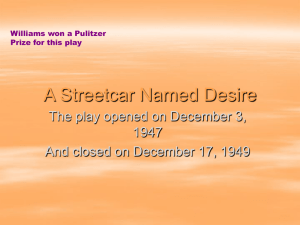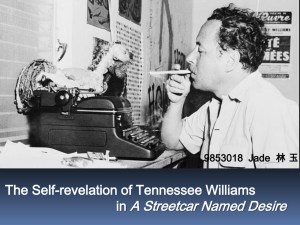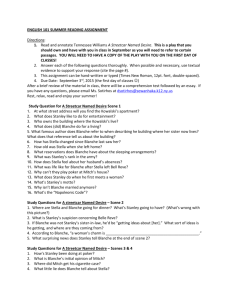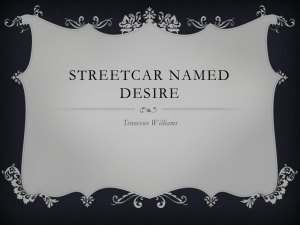Williams* A Street Car names Desire O*Neill*s
advertisement
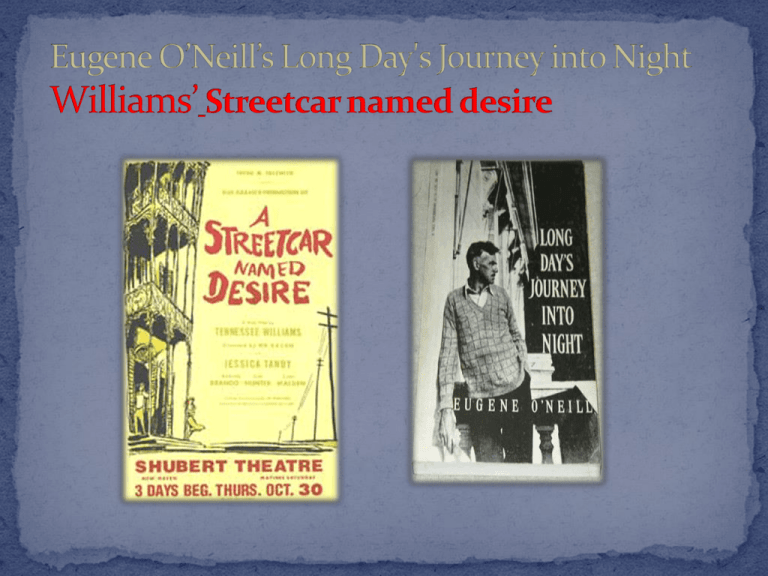
The beginning of the plays The ending of the plays Differences and similarities in terms of structure and characters. Themes Plot The two plays present a remarkable depiction of the realities and fantasies the characters carry within their inner lives Both plays are strikingly dramatic in their characters’ attempt to escape from the hash reality Both Plays seem similar in terms of the flow of structure where the play culmination is harshly presented and employed by both playwrights to show the characters’ inside conflict reaching a climax. Still, Despite the clear similarities, there are major differences that I will illustrate in this presentation A Street Car named Desire Long Day's Journey into Night In this play, the event is geared toward a final climax. ----------------------------Example: Blanche ‘s tries to live in her make-belief world and even admitting that she tends to lie and “I don’t tell the truth”. This is make her feel secure away from the her harsh reality. Stanley on the other hand represent the wake-up call for Blanche who is more immersed in the physical reality, a physical side that even come in sexual image when the make love. It is like Stanley ‘s sexual strike wake Blanche from her romantic dreams. In this play, dramatic tension leading to the climax. -------------------Example: Similar to ‘A Street Car Named Desire’ this play structure is rotating over continuous tensions and climax at the en d with Act 4 where the character reach a climax in an arguments that is a turning point in their life and the pay structure as well. Most character climax is resolved at the end, where as Mary, like Blanche becomes more and more disillusioned and delves deeply into her past. A Street Car named Desire Long Day's Journey into Night In this play, there are eleven scenes; each one include new tensions dramatically contributes more and more toward the high and final climax. ----------------------------Example: Each Act in the play contains more drama that prepares the reader towards the end, we see Williams building more and more to widen the gap between reality and fantasy, preparing for the play climax in the last Act. This reflected in Blanche in the last Act descending deeper into her past and illusions. - Gradual development of events with final climax In this play, there are four Acts depicting the dramatic tension building up towards the softer climax than ‘A Street Car Names Desire’. -------------------Example: Unlike, ‘A Street Car Names Desire’, the play takes place in only one day. There is some monotonous flow of actions in the family life. We see all the family argument and confrontations happening at the end of the play where the climax resolves for some characters but for other, Mary, the climax is heightened and she goes down into her past. - Flat flow of event with some tensions at the end. Characters Tennessee Williams’ A Streetcar Named Desire and Eugene O’Neill’s Long Day’s Journey Into Night are dramas centered on the same two dramatic collision, the collision between the world of fantasy and reality collisions, as well as the collision between the worlds of the past and present. Both A Streetcar Named Desire and Long Day’s Journey Into Night present situations in which their characters attempt to use their own worlds of fantasy as vessels to escape their harsh and unkind realities. At the centre of fantasy’s conflict with reality in A Streetcar Named Desire we find Blanche Dubois. If there is one source of all her problems, it would be her staunch refusal to accept her own fate. Though she may not fully comprehend the damages and effects it most certainly has on her, Blanche openly admits to Mitch, “I misrepresent things to them. I don’t tell the truth, I tell what ought to be the truth.” (Sc. 9) By lying to the other characters, Blanche constructs a fantasy that appears the way she believes it should appear, rather than as it does appear. Evidence of the collision between fantasy and reality does not lie solely within Blanche herself, as the collision becomes increasingly apparent once Stanley comes into the picture. Stanley is portrayed as almost the polar opposite of Blanche. He is firmly planted within the physical world, a practical man living comfortably in harmony with reality. From their first meting Stanley recognizes Blanche’s stories as fantasy, and immediately begins to do everything he can to discredit her stories and expose her fabrications. Thus the conflict between Blanche and Stanley that spans the entire length of the drama quite essentially is the conflict between fantasy and reality; a conflict between a woman who lives her entire life as a fantasy and a man grounded entirely in reality. In Long Day’s Journey Into Night each character is shaped to a great degree by their past, and it becomes both a place to take refuge in and a time to blame present circumstances on. As Mary’s morphine use becomes heavier, she retreats further back into idealized memories of her girlhood and her marriage to Tyrone. Her dead child haunts her as well. Tyrone is preoccupied with his past, as he realizes that he has sold out for financial gain rather than any artistic reason. A Street Car named Desire In this play, the characters break out from their cruel realities and circumstances. Long Day's Journey into Night In this play, the characters also find more comfort when they run away from outside to the inside of their inner thoughts and dreams. A Street Car named Desire In this play, the characters are not related by blood and thus each represent different value and backgrounds ----------------------------------------------Blanche is not related to Stanley by blood or family. Blanche moves deeper and deeper to her inner self as the play progresses having some tints of madness. Stanley doesn't like or want any exhibit any family value; he like to be a free agent. Long Day's Journey into Night In this play, the characters are, or seems, as one family, but it is disconnect family -------------------------------------Example: Mary Tyrone lives in her past and present at the same time, Unlike Blanche, she is not maddened by her past memories, but by her addiction to morphine. James represents the family breadwinner of American family, but this family is disconnected in its values and morals. Themes 1- Illusion versus reality 2- The Haunting Presence of the Past 3- Loneliness 4-socitety and class 5- Alcohol and Drug 1- illusion versus reality Long Day's Journey into Night A Street Car namesd Desire In long journey into night, the four members of the Tyrone family live in illusion because they refuse to acknowledge their own failures and weaknesses. Instead, they deny their faults altogether, choosing to blame another family member for them or to argue that they are victims of circumstances. To escape from reality, they take refuge in liquor or, in the case of Mary, morphine. Mary lives in her own world of illusion which appears clearly in her denial of the fact that she is addicted. At the end of the play, each member of the family is an alien in one world; the Tyrones live together separately In Streetcar named Desire, Blanche lives in her own world of illusion because fantasy is her primary means of self-defense, both against outside threats and against her own fears. She is unable to confront the truth as Mary in long journey into night . Throughout the play, Blanche's dependence on illusion is contrasted with Stanley's realism, and in the end it is Stanley and his worldview that win. Moreover, Stella resorts also to a kind of illusion, forcing herself to believe that Blanche's accusations against Stanley are false so that she can continue living with her husband 2- The Haunting Presence of the Past Long Day's Journey into Night A Street Car named Desire Mary dwells on the past. She could have been a nun, she says, or a pianist, and she thinks over the circumstances leading to the death of Eugene. She also regrets leaving the good home provided by her father to marry a traveling actor. Jamie, Edmund, and Mary frequently mock penny-pinching James Tyrone for engaging a “quack” who prescribed morphine to alleviate Mary’s pain when she was giving birth to Edmund. Mary sums up the situation with this memorable line: “The past is the present, isn’t it? It’s the future, too.” In Streetcar named Desire, Blanche also dwells on the past. She still in love with her dead husband and could not find peace after losing him. The writer makes the audience share her recollection of the past memory when she remembers her husband’s suicide by using auditory effects. As she recounts this story, we hear the music from the dance hall, which was playing during the scene she remembers. We are now inside her head. The auditory hallucination represents her guilt and her inability to escape the past 3- Loneliness The theme of loneliness appears clearly in both dramas :long journey into night and Streetcar named Desire. In the first one, Mary is alone all the time. She complains from being alone with no friends or acquaintance. This is because her husband is not social one. Mary's isolation is particularly sharp. She is isolated by her gender, as the only woman of the family, and by her morphine addiction, which pushes her away from reality In the second play, Blanche is lost suffers terrible loneliness. She desperately seeks companionship and protection in the arms of strangers. And she has never recovered from her tragic and consuming love for her first husband. Blanche is in need of a defender. But in New Orleans, she finds merciless Stanley , and return to strangers again saying at the end to the doctor: "Whoever you are – I have always depended on the kindness of strangers." A Street Car named Desire Long Day's Journey into Night Stanley discovers Blanche's past through a co-worker who travels to Laurel frequently, and he confronts her with the things she has been trying to put behind her, partly out of concern that her character flaws may be damaging to the lives of those in her new home, just as they were in Laurel, and partly out of a distaste for pretense in general. However, his attempts to "unmask" her are predictably cruel and violent. Their final confrontation— Williams alludes to rape, but never states it directly—results in Blanche's nervous breakdown. plot of the play is repetitious, just as the cycle of an alcoholic is repetitious. The above arguments occur numerous times throughout the four acts and five scenes. All acts are set in the living room, and all scenes but the last occur either just before or just after a meal. Act II, Scene i is set before lunch; scene ii after lunch; and Act III before dinner. Each act focuses on interplay between two specific characters: Act I features Mary and Tyrone; Act II Tyrone and Jamie, and Edmund and Mary; Act III Mary and Jamie; Act IV Tyrone and Edmund, and Edmund and Jamie A Street Car named Desire Long Day's Journey into Night -The play begins in the evening, early -The play begins in August, 1912, at May of 1947, with Blanche arrives in New the summer home of the Tyrone Orleans to live with her sister, Stella. family. in the morning. It is 8:30 am, -During their first conversation they argue and discuss Blanche's past. and the family has just finished breakfast in the dining room. -Tyrone and Mary make conversation, which leads to a brief argument about Tyrone's tendency to spend money on real estate investing. A Street Car named Desire Long Day's Journey into Night -The ending to A Streetcar Named The play is all the more tragic because Desire is all about cruel and tragic irony. it leaves little hope for the future; indeed, the future for the Tyrones can Blanche is shipped off to a mental only be seen as one long cycle of a institution because she can’t deal with repeated past bound in by alcohol and reality and retreats into illusion – yet morphine. Stella is doing the very same thing by O'Neill does not end the play on any ignoring her sister’s story about Stanley. particular note of condemnation of any character. Rather, the play ends with an image of a resigned family that was once great but has since fallen into despair. Thank you for you attention. 3hood Saba3’ 7aneen Ba7’shwain Rana Al7azmi Huda Aljehani Basma Alma7nabi

